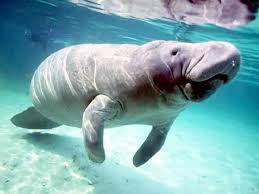Manatees are large, fully aquatic, seal-shaped mammals sometimes known as sea cows. There are three accepted living species – Amazonian manatee, the West Indian manatee and the West African manatee. Manatees are a migratory species and they tend to have a curious nature. They can measure up to 13 feet long, weigh as much as 1,300 pounds and have paddle-like flippers. The females tend to be larger and heavier. They have a large, flexible, prehensile upper lip. They use the lip to gather food and eat, as well as using it for social interactions and communications. Their small, widely spaced eyes have eyelids that close in a circular manner. Uniquely among mammals, their teeth are continuously replaced throughout their life. Their closest relative are the elephant and the hyrax (a small, gopher-sized mammal).
Manatees produce enormous amounts of gas, which contributes to their barrel-shape, to aid in the digestion of their food. Half a manatee’s day is spent sleeping in the water, surfacing for air regularly at intervals no greater than 20 minutes. They spend the rest of their time grazing in shallow waters up to depths of 2 metres. They are gentle and slow-moving animals and on average they swim at about 5-8 kilometres per hour. However, if required they have been known to swim up to 30 kilometres per hour in short bursts. They typically breed once every two years and normally only a single calf is born at a time (twins are rare). Aside from mothers with their young or males following a receptive female, manatees are generally solitary creatures. After breeding, the male manatee has no further involvement with the mother or calf.
They emit a wide range of sounds used in communication, especially between adults and their young. Manatees are herbivores and eat over 60 different plant species such as mangrove leaves, turtle grass and types of algae. They commonly eat up to 10% of their body weight per day. They have also been known to eat small amounts of fish from nets. Manatees inhabit the shallow, marshy coastal areas and rivers of the Caribbean Sea and the Gulf of Mexico and the Amazon basin. The freshwater Amazonian manatee inhabits the Amazon river and its tributaries and never ventures into salt water. The Amazonian’s hair colour is brownish gray and they have thick, wrinkled skin, often with coarse hair or whiskers. I have been fortunate to observe manatees in both Rio Dulce (Guatemala) and off the island of Ambergris Caye (Belize).
The manatees are a threatened species – the main threat are human-related issues such as habitat destruction and boat collisions as well as natural causes such as disease. Brazil outlawed hunting in 1973 in an effort to protect the species. Save the Manatees Club’s mission is to protect endangered manatees and their aquatic habitat for future generations.
Lloyd Boutcher,
Director Sunvil Traveller





